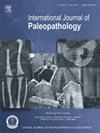Paleoparasitological evidence of helminth infections in individuals from two Late Iron Age necropolises in Northern Italy (3rd-1st c. BCE)
IF 1.5
3区 地球科学
Q3 PALEONTOLOGY
引用次数: 0
Abstract
Objective
Evaluate the presence of digestive macroparasites (helminths) in human remains from the Late Iron Age (3rd-1st c. BCE) in northern Italy (Verona province).
Materials
Pelvic soil samples and control samples from the skull or foot areas of 55 individuals from the necropolises of Seminario Vescovile (n = 45) and Povegliano Veronese (n = 10).
Methods
All samples were examined using brightfield optical microscopy. In addition, soil samples from 10 individuals from Seminario were analysed through paleogenetic methods in order to complement the microscopic analysis.
Results
Thirty Ascaridida eggs in pelvic samples from 6 individuals (3 from Seminario and 3 from Povegliano: 6.7 % and 30 % of the respective samples) were evaluated. Evidence of roundworm infection was observed in both sexes and in adults and non-adult individuals.
Conclusion
The presence of Ascaridida, likely Ascaris sp., eggs at both sites suggests that ineffective sanitation may have contributed to parasite exposure in these Late Iron Age communities.
Significance
This study provides novel insights into environmental and health risks among Iron Age communities. It also highlights the need for a critical assessment of taphonomic factors and sampling procedures when interpreting paleoparasitological data.
Limitations
The low frequency of identified eggs and the absence of recoverable parasite DNA at Seminario highlight taphonomic factors as a potential source of bias. The limited sample size from Povegliano also warrants caution in interpretation.
Suggestions for further research
Future studies integrating paleoparasitological and anthropological data are essential to evaluate the prevalence of parasitic infections in Iron Age populations from the Italian Peninsula.
意大利北部两个铁器时代晚期墓地(公元前3 -公元前1年)个体中寄生虫感染的古寄生虫学证据
目的评估意大利北部维罗纳省铁器时代晚期(公元前3 -公元前1年)人类遗骸中消化道大型寄生虫(蠕虫)的存在情况。材料:来自Seminario Vescovile( = 45)和Povegliano Veronese( = 10)墓地的55个个体的头骨或足部的骨盆土壤样本和对照样本。方法采用明光场显微镜检查。此外,通过古成因方法分析了塞米纳里奥10个个体的土壤样品,以补充微观分析。结果共检测到6例个体(Seminario和Povegliano各3例,分别占6.7 %和30 %)盆腔内蛔虫卵30个。蛔虫感染的证据在两性、成人和非成人个体中均有发现。结论在这两个地点均发现蛔虫卵,很可能是蛔虫属,表明在这些铁器时代晚期的社区中,卫生条件不佳可能是导致寄生虫暴露的原因之一。这项研究为铁器时代社区的环境和健康风险提供了新的见解。它还强调了在解释古寄生虫学数据时对地形学因素和抽样程序进行批判性评估的必要性。局限性:在塞米纳里奥,鉴定出的卵的频率较低,而且缺乏可恢复的寄生虫DNA,这突出了表型因素是偏见的潜在来源。Povegliano有限的样本量在解释时也需要谨慎。未来整合古寄生虫学和人类学数据的研究对于评估意大利半岛铁器时代人群中寄生虫感染的流行程度至关重要。
本文章由计算机程序翻译,如有差异,请以英文原文为准。
求助全文
约1分钟内获得全文
求助全文
来源期刊

International Journal of Paleopathology
PALEONTOLOGY-PATHOLOGY
CiteScore
2.90
自引率
25.00%
发文量
43
期刊介绍:
Paleopathology is the study and application of methods and techniques for investigating diseases and related conditions from skeletal and soft tissue remains. The International Journal of Paleopathology (IJPP) will publish original and significant articles on human and animal (including hominids) disease, based upon the study of physical remains, including osseous, dental, and preserved soft tissues at a range of methodological levels, from direct observation to molecular, chemical, histological and radiographic analysis. Discussion of ways in which these methods can be applied to the reconstruction of health, disease and life histories in the past is central to the discipline, so the journal would also encourage papers covering interpretive and theoretical issues, and those that place the study of disease at the centre of a bioarchaeological or biocultural approach. Papers dealing with historical evidence relating to disease in the past (rather than history of medicine) will also be published. The journal will also accept significant studies that applied previously developed techniques to new materials, setting the research in the context of current debates on past human and animal health.
 求助内容:
求助内容: 应助结果提醒方式:
应助结果提醒方式:


